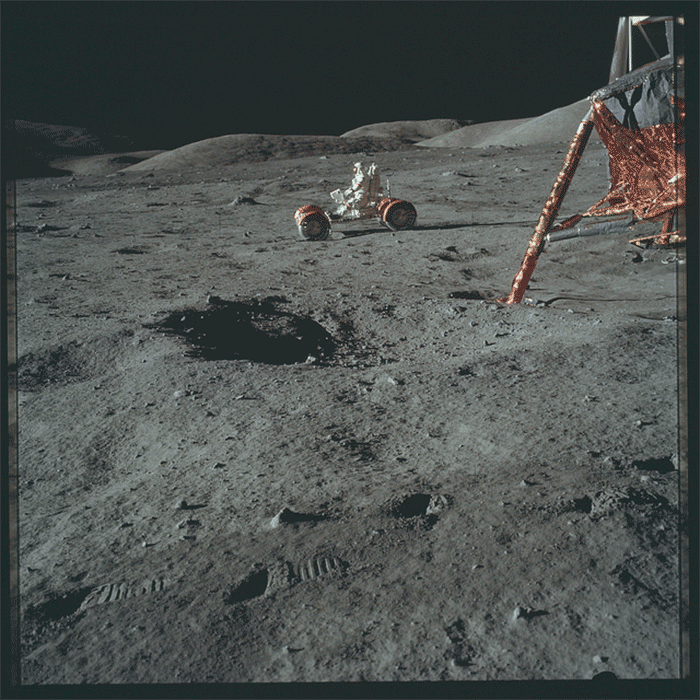GIFs in Space!
The format gives classic photos from the Apollo missions new life.

Want to feel like an old-timey astronaut? You can trawl auction houses for lunar artifacts mistakenly put up for sale. You can travel to a Dairy Queen in Franklin, Pennsylvania, and pose outside of a model of the Apollo command module. Or—and this is much simpler—you can watch a GIF of a moon buggy rough-riding over some craters, as above.
This spacey experience was put together by Chaz Hutton, a comedian from Australia. Earlier this month, inspired by Jared Kinsler’s similar curation project, Hutton went through all of the photos in the Project Apollo Archive and made some of them move.
The archive contains 14,227 images, taken over the course of the 10 manned Apollo missions. Starting with Apollo 8, astronauts brought electric Hasselblad EL cameras with them to space. As Gary Kitmacher explained on the NASA History Program website, these cameras “largely automated the picture-taking process.” Astronauts only had to point and shoot, and the Hasselblads took care of everything else, from tensioning the shutter to re-winding the film.
Likely for this reason, “a lot of [the images] are shot in sequence—the same scene set out over 20 or 30 photographs,” Hutton explains. “Even when you’re scrolling through, you almost get an animated effect. And so I was like, ‘Hang on a second—a lot of these can be turned into GIFs.’” (He collected his in two Medium posts, which you can see here and here. NASA also has their own GIPHY page, which features more examples, both historic and contemporary.)

On their own, photographs can be like magic, dropping the viewer into a time or place they could otherwise only imagine. But people who want to feel still more present in these scenes have found a number of ways to shrink this distance even further. Artists carefully colorize black-and-white images, removing the barrier to empathy that can come with monochromatics. Or archivists place photos in their geographic context, so that viewers familiar with a particular spot can see exactly what that place once looked like.
As a comedian, Hutton originally intended to bridge this gap through humor: “My first thought was, what if I went through the archive and found all the shit photos?” he says. (There are many.) But the choppy motion of the GIFs provided another immediate entry point. “You get a sense of the height, and where everything is in relation to each other,” he says.
For example, there’s a pair of GIFs that comes from the Apollo 9 mission. They show the lunar module (nicknamed Spider) flying separately from the command module (nicknamed Gumdrop), with two astronauts aboard. They were testing Spider to make sure it could properly detach from Gumdrop, fly far away—say, to the moon—come back up, and then reattach.
In the first GIF, Spider is leaving Gumdrop, careening off into space. Its “United States” license plate flashes defiantly as the Earth spins in the background. In the second, it’s returning, emerging from the whirl of clouds and heading straight back to Gumdrop. You can almost imagine the photographers sighing with relief.

Another high point is the panoramic shots. On most missions, a moonwalking photographer took a moment to spin around in a circle and take photos of the local environs: craters, equipment, and fellow astronauts. “It’s almost like you’re in Google Street View,” says Hutton.
And then there are those GIFs that—depending on your particular constitution—might make you glad you’re not actually there. One of Hutton’s favorites shows a spacewalk from Apollo 17, during which Ron Evans retrieved some instrument film from a service module outside the main spacecraft. The walk took place halfway between the Earth and the Moon. “To me, that’s like going for a swim in the middle of the Pacific,” says Hutton.
Viewed one by one, these images show a trained professional, capably going about his job. The GIF shows the same thing, but the camera bobs and sways. Watching it, you feel one bad grab away from the infinite abyss of space. It’s a good thing to empathize with, from the safety of your computer.


















Follow us on Twitter to get the latest on the world's hidden wonders.
Like us on Facebook to get the latest on the world's hidden wonders.
Follow us on Twitter Like us on Facebook